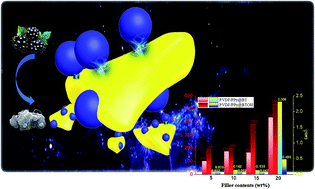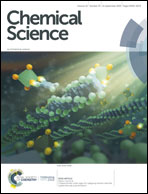Achieving high performance poly(vinylidene fluoride) dielectric composites via in situ polymerization of polypyrrole nanoparticles on hydroxylated BaTiO3 particles†
Abstract
Polymer dielectric composites have widespread applications in many fields ranging from energy storage, microelectronic devices, and sensors to power driven systems, etc. and attract much attention of researchers. However, it is still challenging to prepare advanced polymer dielectric composites with a high dielectric constant (ε′), low dielectric loss (tan δ) and simultaneously high breakdown strength (Ebd). In this work, conductive polypyrrole (PPy) nanoparticles were in situ synthesized in a reaction system containing the common barium titanate (BaTiO3, BT) or hydroxylated BaTiO3 (BTOH) particles, and then the PPy@BT and PPy@BTOH composite particles were incorporated into poly(vinylidene fluoride) (PVDF) to prepare the composites. The morphologies and microstructures of the PPy@BT and PPy@BTOH composite particles and the corresponding PVDF composites were comparatively investigated. The results showed that the PPy@BTOH composite particles had a ‘mulberry’-like morphology with a rough surface and the self-assembled structure could be maintained in the PVDF composites, which was apparently different from the PVDF/PPy@BT composites, in which most of the PPy nanoparticles dissociatively dispersed in the PVDF matrix. Electrical conductivity measurements showed that at high particle content (≥20 wt%), the PPy@BTOH composite particles endowed the composites with lower electrical conductivity compared with the PPy@BT composite particles. Dielectric property measurements showed that the ‘mulberry’-like PPy@BTOH composite particles endowed the PVDF composites with extremely high ε′, ultralow tan δ and high Ebd compared with the PVDF/PPy@BT composites with dissociatively dispersed PPy nanoparticles and BaTiO3 particles. The polarization and loss mechanisms of the composites were then proposed based on the morphologies and the microstructures of the composites. This work provides an alternative way to fabricate functional dielectric particles through trace functional groups inducing in situ polymerization of conductive polymers, and these particles can be used to fabricate advanced dielectric composites.



 Please wait while we load your content...
Please wait while we load your content...